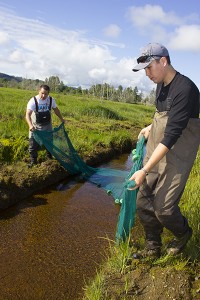
Northwest Indian Fisheries Commission
The Skokomish Tribe has solid data showing how salmon are using the Skokomish Tidelands after a year of monitoring the 400-acre restored estuary.
While the tribe monitors the estuary year round, the first full year of sampling (December 2011 to November 2012) showed 20 fish species, including chinook, chum and coho salmon, using both the large and small tidal channels in the restored areas of the estuary.
Prior to 2006, the estuaries had been filled with fish-blocking culverts, dikes and roads for 70 years, preventing development of good fish habitat. Restoration started in 2007, which included removing man-made structures and opening historic tidal channels that allow juvenile fish to find places to feed and hide while heading out to the ocean.
“Chinook were found in 90 percent of the channels and chum were found in 100 percent of them,” said Matt Kowalski, the tribe’s steelhead biologist. “This proves that salmon have access to and are utilizing the restoration sites.”
All 20 different species were captured in large channels, while only nine different species were captured in small channels and were mostly salmon, stickleback and sculpins, he said.
“Some of the small channels are old drainage ditches that had limited fish access and others are completely newly formed channels from the restoration,” Kowalski said. “Over time, a more complex system of small channels will form and provide more and higher quality habitat for fish.”
In addition to fish monitoring, restoration work will continue this summer with more dike and culvert removal, connecting the restored 400-acre estuary to 600 acres of forested wetlands.
